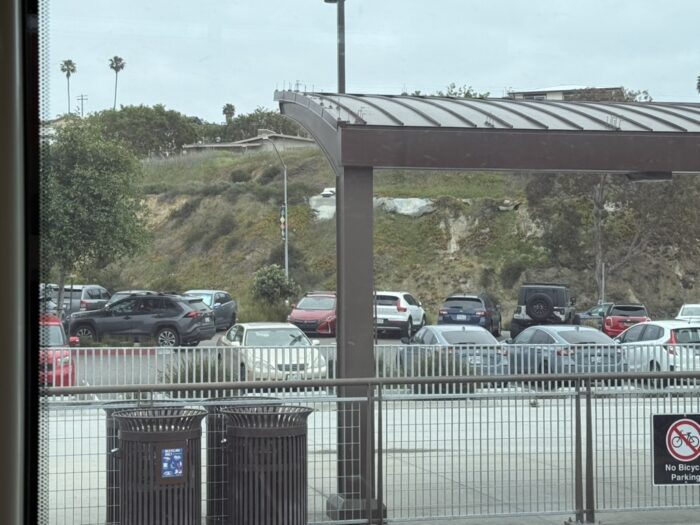
A San Diego Trolley station with no destinations other than parking, viewed from the train.
There is a lot of confusion out there about Park-and-Ride. Is it necessary for ridership? Are motorists entitled to it? Can it last forever?
Let’s start with the basic math.
- Really great transit generates high land value around stations.
- Free parking presumes low land value around stations.
It’s a contradiction.
When a transit agency provides free or underpriced parking at a station where the land value signals that there is a higher use, it is subsidizing motorists in two ways. First, it is forcing a low-value land use to prevail over a high value land use, and second it is making a much bigger investment in access by motorists than it makes in access by people who get to the station in other ways. I am using the word subsidy in exactly the same sense that any other artificial limit on price is a subsidy.
Obviously the problem is much worse where the rapid transit is of the highest utility and quality and where the ambient land value is therefore higher. This is why free Park-and-Ride is much harder to justify on high-frequency metro systems than on infrequent outer-suburban commuter rail in most metro areas.
Low-cost Park-and-Ride can make great sense where a station area is undevelopable (floodplains etc). There’s also an important role for distributed, small-scale Park-and-Ride created by sharing existing spaces. Transit agencies often make deals to share parking with land uses that peak on weekends and evenings, such as houses of worship and entertainment venues. These are great ways of providing some car access at very little cost to the public.
But the law of supply and demand generates some facts about free Park-and-Ride that many people don’t want to hear, but that we really can’t protect them from:
- Free parking at a high-utility rapid transit station is a price subsidy, exactly the way the Soviet Union’s caps on retail prices were. It has the same effect, which is to cause problems of supply: Empty shelves in Soviet grocery stores, Park-and-Rides that fill up at 7 AM. If a commodity is priced too low in a condition of high demand, its supply will be exhausted, making it unavailable.
- A Park-and-Ride that fills up at 7 AM is effectively one that doesn’t exist over much of the time period when it’s supposedly needed. This loss of utility for people who travel later is a direct consequence of the price subsidy, as the artificially low price prevents the transit agency and its customers from reaching a market equilibrium where supply and demand of parking are in balance. (This equilibrium, of course, would be optimal for both ridership and revenue. Parking that fills up too soon drives away riders as effectively as no parking would.)
- The claim that Park-and-Ride is needed to attract riders is true only in the earliest phases of development, or on transit services with limited utility like peak-only express service. Once land value rises in response to transit access, the highest source of ridership is also the economically highest use of the land: dense, transit-oriented development around the station combined with good provision for the space-efficient forms of access (i.e. everything but Park-and-Ride). This is why Park-and-Ride is often a logical interim use of land, but not one that you should plan on having forever. Once a city has grown in around a transit system, there may be little Park-and-Ride left at rail stations, and only massive, distorting subsidies will make it free.
- Preventing high-value dense development on naturally expensive station-area land forces that development to locate away from the rapid transit system instead, creating a less sustainable urban structure in which more people and businesses lack excellent transit options.
- People who take buses or bikes or their feet or Kiss-and-Ride to a rail station are being mathematically correct (and fiscally conservative) when they object to free Park-and-Ride at high-demand stations, especially if the agency is not offering a corresponding subsidy to their own preferred modes of access, which all use scarce space more efficiently.
- All of these problems around Park-and-Ride can be resolved only by charging a fair market price for the rental of expensive, publicly owned real estate. Once parking is priced that way, it can remain the best use of valuable land. As always, the problem is not parking, per se. The problem is the market distortion arising from the subsidy.
It’s easy to feel entitled to a free Park-and-Ride space. But nobody can repeal the law of supply and demand, and that’s what we’re dealing with here.
Photo: Park and Ride at Auckland’s Constellation Station, Auckland Transport